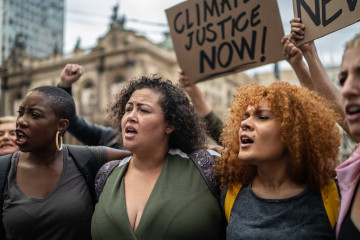Society is increasingly concerned about how business activities can impact people, communities, and the environment. Employees, customers, investors, governments not only expect, but demand, that companies integrate human rights into their business practices. In response to these calls, many companies now commit to voluntary initiatives, such as the United Nations Global Compact, and refer to human rights in their internal and external codes of conduct.
In our webinar moderated by Nate Kimball, Sustainability Practice leader, human rights professionals Sara Rowland, ESG Advisory Services leader, and Bradford Conroy, Senior Professional, discuss the latest in corporate human rights frameworks and expectations. Our experts explain how the business and human rights landscape is shifting from voluntary standards to mandatory human rights and environmental due diligence (mHREDD).
If you missed it, check out the full webinar on-demand below.
Watch On-DemandWhat are Human Rights?
To better understand human rights, it is important to ground ourselves in who has defined human rights and where expectations come from.
Human rights are basic standards aimed at securing dignity and equality for all. They are universal standards that, as stated in the Universal Declaration of Human Rights, express the “…recognition of the inherent dignity and of the equal and inalienable rights of all members of the human family [as] the foundation of freedom, justice, and peace in the world.” Human rights include people’s fundamental right to basic needs (like food, water, housing health, education, and work), bodily integrity (life, liberty, security, freedom of movement, and freedom from slavery, and torture), and civil liberties (like right to a fair trial, opinion & expression, assembly, belief & religion, association, culture, political participation, and privacy). These are the internationally agreed-upon fundamental human rights. These rights are stated and reinforced in 4 key documents:
- Universal Declaration of Human Rights (UDHR) – 1948
- International Covenant on Civil & Political Rights (ICCPR) – 1966
- International Covenant on Economic, Social, & Cultural Rights (ICESCR) – 1966
- International labor organization (ILO) Declaration on Fundamental Principles & Rights at Work – 1998
There are two additional documents that articulate the expectations for businesses regarding human rights that have shaped the legislative landscape.
The first document is the United Nations Guiding Principles (UNGPs).
The UNGPs were developed by John Ruggie, the UN Secretary-General's Special Representative for Business and Human Rights, to implement the Protect, Respect and Remedy Framework. This framework is based on 31 principles that provided the first global standard for preventing and addressing the risk of adverse impacts on human rights linked to business activity. The UNGPs encompass three pillars outlining how states and businesses should implement the framework:
- the state duty to protect human rights,
- the corporate responsibility to respect human rights,
- and access to remedy for victims of business-related abuses.
In 2011, the United Nations Human Rights Council unanimously endorsed the UNGPs, making them the first corporate human rights responsibility initiative to be endorsed by the UN. The UNGPs have gained wide support from states, civil society organizations, and the private sector, further solidifying their status as the key global foundation for business and human rights.
The second key document is the OECD Guidelines.
These are recommendations on responsible business conduct addressed by governments to multinational enterprises. They were adopted in 1976 and last revised in 2011. The OECD Due Diligence Guidance for Responsible Business Conduct was adopted in 2018 and provides a useful 6-step process for conducting due diligence to understand the adverse impacts that a company may have on people and planet and how they can begin to address these impacts.
Expectations for Business
The level of expectations for businesses can depend on a variety of factors. Below, the chart outlines the different expectations based on degrees of involvement:
- Cause: the business is expected to cease or prevent impact and provide/cooperate in remediation.
- Contribute: the business is expected to cease or prevent contribution, use leverage to address remaining impact and provide or cooperate in remediation.
- Directly Linked: the business is expected to use leverage to seek to prevent and mitigate impacts.
Voluntary vs. Mandatory
The expectations outlined in the UNGPs and OECD Guidelines are quickly becoming legal requirements. While human rights requirements have been highlighted most recently in the EU with the EU CSRDD and Germany Supply Chain Act, there are also important developments occurring in the U.S. For example, the Uyghur Forced Labor Prevention Act and US-Mexico-Canada Act both aim to enforce the requirement for businesses to ensure that human rights are respected in their value chains.
Businesses should also keep in mind that they can still be impacted by regulations in other countries. For example, the EU Corporate Sustainability Reporting Directive (CSRD). As part of this directive, non-EU companies with a significant presence in the EU will be subject to the reporting requirements as outlined in the CSRD.
The spotlight on business and human rights is heightened, and we will continue to see an increase in mandatory human rights and environmental due diligence (mHREDD) measures. MHREDD is part of a directive intended to take due diligence a step further, enabling companies to focus attention on the most severe risks.
Ultimately, the takeaway here is that we can expect to see legislation and regulations grow. So, now is the time to prepare and begin incorporating human rights considerations into your business operations.
Getting Started in Your Business
Human rights issues can seem overwhelming, but beginning by understanding the UNGPs is a great place to start. Not only will this help you understand how human rights apply to your business’s operations, but it can also help you to understand where human rights expectations come from and how they apply to all of us. The UNGPs reporting framework is an excellent resource to find guidance on the 31 principles and how to report on them.
You can then begin to explore the adverse impacts your business operations are having on people and the planet.
Keep in mind, this won’t happen overnight.
Start by mapping out your value chain to the extent that you can and from there, break the value chain up into “nodes.” For each node in your value chain identify which groups of people are involved and how they might be impacted by your operations. Once you identify potential impacts, you can take a deeper dive to determine which ones are most crucial and salient to your business and begin to address them.
Another great beginning step is to incorporate human rights considerations into your existing policies and procedures. Start asking the difficult questions about how your operations are impacting people, directly or indirectly, and work towards resolving those impacts by updating existing policies. Remember, human rights responsibilities typically fall across the organization, so it may be necessary to involve a variety of teams (i.e. sustainability and CSR, business operations, legal audit and compliance, public affairs, investor relations, etc.).
The Value of Investing in Human Rights
Trying to communicate the value of investing in human rights can be a difficult conversation to have with your C-suite. It can be helpful to break it down into two sides: mitigating risk and capturing business value.
Start by discussing the risks associated with human rights issues. This can range from risks to your brand reputation, litigation risks, and business continuity risks. All these risks pose a threat if not addressed and could lead to a loss of profits, customers, employees, and even partners and suppliers.
The second side of the conversation should focus on the value created by addressing human rights impacts.
More and more often consumers and other stakeholders are looking for companies to publicly disclose their environment, social, and governance (ESG) and sustainability efforts. Human rights can be one element of these communications. Companies making efforts to address their human rights impacts can use these efforts to drive communications around sustainability and ESG.
However, this can be called greenwashing if a business is not addressing their most salient impacts, once again highlighting the importance of understanding your businesses adverse impacts across the value chain.
Key Takeaways
Human rights are becoming a standard that companies are expected to address and are increasingly used by companies and their stakeholders as the normative framework for evaluating social aspects of sustainability. Actions on human rights are moving from voluntary to mandatory, meaning that now is the time to take the necessary steps to understand your organization's impact across the value chain on people and the planet.
If you’re feeling overwhelmed or don’t know where to start, don’t worry! Our team of human rights experts is here to help you out, wherever you might be on your journey.
Want more news and insights like this?
Sign up for our monthly e-newsletter, The New Leaf. Our goal is to keep you updated, educated, and even a bit entertained as it relates to all things EHS and sustainability.
Have any questions?
Contact us to discuss your environment, health, safety, and sustainability needs today.






